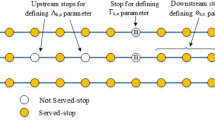Abstract
Public transport service is subject to multiple sources of uncertainty that impact its reliability. Holding control strategies are a common method to prevent the deterioration of service reliability along the route. This paper expands on previous studies by considering the general case of determining both the optimal number and optimal location of the time point stops (TPS) where holding takes place, and assessing their impacts on transit performance using simulation. Holding times are determined based on a real-time headway-based holding strategy designed to improve service regularity by seeking uniform headways along the route. The evaluation of the performance of alternative TPS layouts is simulation-based, using BusMezzo, a transit operations simulation model which models the dynamic performance of bus transit systems. The proposed framework also considers the multiple objectives incorporating passenger and operator points of view. The simulation-based optimization framework was applied in a case study with one of the premium bus lines in Stockholm, Sweden, using two solution methods—greedy and genetic algorithms. A multi-objective evaluation was conducted considering both passenger and operator perspectives. The results demonstrate that transit performance varies considerably with alternative TPS layouts. The best solution obtained by the proposed methodology reduces total weighted passenger journey times and cycle times compared to both the current layout and the case of no holding control. The proposed method could assist transit agencies and operators in evaluating and recommending alternative time point layouts.












Similar content being viewed by others
Explore related subjects
Discover the latest articles, news and stories from top researchers in related subjects.References
Abkowitz M, Engelstein I (1984) Methods for maintaining transit service regularity. Transp Res Rec 961:1–8
Cats O, Larijani AN, Burghout W, Koutsopoulos HN (2011) Impacts of holding control strategies on transit performance: a bus simulation model analysis. Transp Res Rec 2216:51–58
Cats O, Larijani AN, Ólafsdóttir A, Burghout W, Andreasson I, Koutsopoulos HN (2012) Holding control strategies: a simulation-based evaluation and guidelines for implementation. Transp Res Rec 2274:100–108
Cortes CE, Saez D, Milla F, Nunez A, Riquelme M (2010) Hybrid predictive control for real-time optimization of public transport systems’ operations based on evolutionary multi-objective optimization. Transp Res Part C 18:757–769
Delgado F, Munoz JC, Giesen R, Cipriano A (2009) Real-time control of buses in a transit corridor based on vehicle holding and boarding limits. Transp Res Rec 2090:59–67
Eberlein XJ, Wilson NHM, Bernstein D (2001) The holding problem with real-time information available. Transp Sci 35(1):1–18
Furth PG, Miller THJ (2009) Optimality conditions for public transport schedules with timepoint holding. Public Transp 1:87–102
Grube P, Cipriano A (2010) Comparison of simple and model predictive control strategies for the holding problem in a metro train system. IET Intel Transp Syst 4(2):161–175
Hickman MD (2001) An analytical stochastic model for the transit vehicle holding problem. Transp Sci 35(3):215–237
Holland JH (1992) Adaptation in natural and artificial systems: An introductory analysis with applications to biology, control and artificial intelligence. MIT press
Konak A, Coit DW, Smith AC (2006) Multi-objective optimization using genetic algorithms: a tutorial. Reliab Eng Syst Saf 91(9):992–1007. doi:10.1016/j.ress.2005.11.018
Liu G, Wirasinghe SC (2001) A simulation model of reliable schedule design for a fixed transit route. J Adv Transp 35(2):145–174
Mazloumi E, Mesbah M, Ceder A, Moridpour S, Currie G (2012) Efficient transit schedule design of timing points: a comparison of ant colony and genetic algorithms. Transp Res Part B 46:217–234
Rossetti MD, Turitto T (1998) Comparing static and dynamic threshold based control strategies. Transp Res Part A 32(8):607–620
Seneviratne PN (1990) Analysis of on-time performance of bus services using simulation. J Transp Eng 116:517–531
Sun A, Hickman M (2008) The holding problem at multiple holding stations. Computer-aided Systems in Public Transport. Lect Notes Econ Math Sys 600(3):339–359
TCRP (2000) Data analysis for bus planning and monitoring. Transportation Research Board, Synthesis of transit practice 34, Washington, DC
TCRP (2003) Transit capacity and quality of service manual (TCQSM) 2nd edition. Transportation Research Board, TCRP Report 100, Washington, DC. http://onlinepubs.trb.org/onlinepubs/tcrp/tcrp100/part%203.pdf
Toledo T, Cats O, Burghout W, Koutsopoulos HN (2010) Mesoscopic simulation for transit operations. Transp Res Part C Emerg Technol 18(6):896–908
Turnquist MA, Blume SW (1980) Evaluating potential effectiveness of headway control strategies for transit systems. Transp Res Rec 746:25–29
Yu B, Yang Z (2009) A dynamic holding strategy in public transport systems with real-time information. Appl Intell 31:69–80
Author information
Authors and Affiliations
Corresponding author
Rights and permissions
About this article
Cite this article
Cats, O., Rufi, F.M. & Koutsopoulos, H.N. Optimizing the number and location of time point stops. Public Transp 6, 215–235 (2014). https://doi.org/10.1007/s12469-014-0092-1
Published:
Issue Date:
DOI: https://doi.org/10.1007/s12469-014-0092-1




